|
Cape Verde
The Republic of Cape Verde (Portuguese: Cabo
Verde) are located on an archipelago in the
Macaronesia ecoregion of the North Atlantic
Ocean, off the western coast of Africa. The previously uninhabited islands were
discovered and colonised by the Portuguese in the fifteenth century, gaining
independence in 1975.
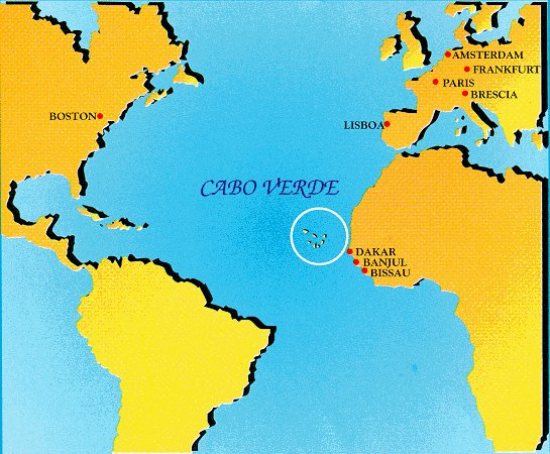 
History
In 1462, Portuguese settlers arrived at
Santiago and founded Ribeira Grande (now Cidade
Velha), the first permanent European settlement city in
the tropics. They named the islands Cabo Verde,
after the nearby Cap Vert on the Senegalese coast. In the 16th century, the archipelago prospered from the
transatlantic slave trade. Pirates occasionally attacked the Portuguese settlements and Sir Francis
Drake ransacked Ribeira Grande in 1585. After a French
attack in 1712, the city declined in importance relative to Praia, which became the capital in 1770. With the decline in the slave
trade, Cape Verde's early prosperity slowly vanished. However, the islands'
position astride mid-Atlantic shipping lanes made Cape Verde an ideal location
for re-supplying ships. Because of its excellent harbour, Mindelo became an important commercial centre during the 19th
century.
Portugal changed Cape Verde's status from a colony to an
overseas province in 1951 in an attempt to blunt growing nationalism. Nevertheless, in 1956, Amilcar Cabral, a
Cape Verdean, and a group of Cape Verdeans and Guinean organized (in Portuguese
Guinea) the clandestine African Party for the
Independence of Guinea and Cape Verde (PAIGC), which
demanded improvement in economic, social, and political conditions in Cape Verde
and Guinea and formed the basis of the two nations' independence movement.
Moving its headquarters to Conarkry, Guinea in 1960, the
PAIGC began an armed rebellion against Portugal in 1961. Acts of sabotage
eventually grew into a war in Portuguese Guinea that
pitted 10,000 Soviet bloc-supported PAIGC soldiers
against 35,000 Portuguese and African troops. By 1972, the PAIGC controlled much
of Portuguese Guinea despite the presence of the Portuguese troops, but the
organization did not attempt to disrupt Portuguese control in Cape Verde.
Portuguese Guinea declared independence in 1973 and was granted de jure
independence in 1974. Following the April 1974 revolution in
Portugal, the PAIGC became an active political movement
in Cape Verde. In December 1974, the PAIGC and Portugal signed an agreement
providing for a transitional government composed of Portuguese and Cape
Verdeans. On June 30, 1975, Cape Verdeans elected a National Assembly, which
received the instruments of independence from Portugal on July 5,
1975.
Immediately following the November 1980 coup in Guinea-Bissau,
relations between Cape Verde and Guinea-Bissau became
strained. Cape Verde abandoned its hope for unity with Guinea-Bissau and formed
the African Party for the Independence of Cape Verde
(PAICV). Problems have since been resolved, and relations between the countries
are good. The PAICV and its predecessor established a one-party system and ruled
Cape Verde from independence until 1990.
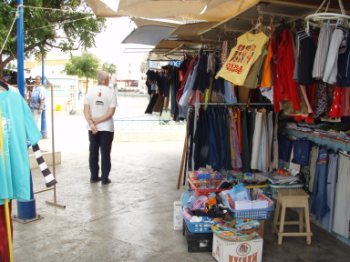  
Bear in Mindelo
market, on-going building work. A
water 'pick-up' (next to the Telecom). Water is
dropped from tankers and locals gather it in drums.
Politics
Cape Verde is a
stable democracy. The Cape Verde constitution—adopted in
1980 and revised in 1992, 1995, and 1999—forms the basis of government. The
president is head of state
and is elected by popular vote for a 5-year term. The
prime minister is head of government
and proposes other ministers and secretaries of state. The prime minister is
nominated by the National Assembly and appointed by the
president. Members of the National Assembly are elected by popular vote for
5-year terms. Three parties now hold seats in the National Assembly--PAICV 40,
MPD 30, and Cape Verdean Independent Democratic Union (UCID) 2. The judicial
system is comprised of a Supreme Court of Justice—whose members are appointed by
the president, the National Assembly, and the Board of the Judiciary—and
regional courts. Separate courts hear civil, constitutional, and criminal cases.
Appeal is to the Supreme Court.
Cape Verde follows a policy of nonalignment and seeks cooperative relations with all friendly
states. Angola, Brazil, China, Cuba,
France, Germany, Portugal, Senegal, Russia, and the USA
maintain embassies in Praia. Cape Verde is actively
interested in foreign affairs, especially in Africa. It
has bilateral relations with some Lusophone nations and holds membership in a number of international
organizations. It also participates in most international conferences on
economic and political issues. Cape Verde has a Special Partnership
status with the EU and might apply for membership. The military of Cape
Verde consists of a coast guard and
an army; 0.7% of the country's GDP was spent on the military in 2005.
Geography and climate
The Cape Verde archipelago is located approximately 375 miles
off the coast of West Africa. It is composed of ten islands (of which nine are
inhabited) and eight islets. The islands have a combined size of just over 4,000
square kilometers. The islands are divided into the Barlavento (windward) islands (Santo Antao, Sao Vicente, Santa Luzia, Sao Nicolau, Sal,
and Boa Vista) and the Sotavento (leeward) islands (Maio,
Santiago,
Fogo, and Brava).These islands are divided into 22 municipalities (concelhos) and subdivided into 32 parishes
(freguesias). The largest island, both in size and population, is
Santiago, where the capital of Praia is located. Though
Cape Verde's islands are all volcanic in origin, they vary widely in terrain.
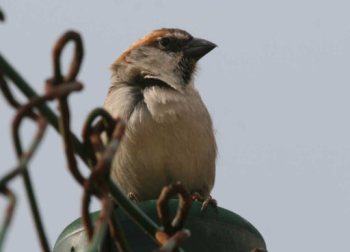  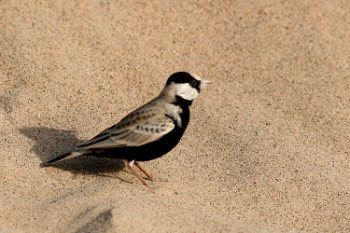
The normal scenery to see a sparrow, in lush plants on Cape Verde and the black crowned sparrow on the beach.
A still-active volcano on the island of
Fogo is the highest point on the
archipelago (elevation 2,829 meters). Extensive salt flats are found on Sal and Maio. On Santiago, Santo Antão, and São
Nicolau, arid slopes give way in places to sugarcane fields or banana
plantations spread along the base of towering mountains. Cape Verde’s climate is
milder than that of the African mainland; because the island is surrounded by
the sea, temperatures are generally moderate. Average daily high temperatures
range from 25 °C (75? °F) in January to 29 °C (85 °F) in September. Cape Verde
is part of the Sahelian arid belt and lacks the rainfall levels of West African
countries. When it does rain, most of the rainfall occurs between August and
October, with several brief, heavy downpours.
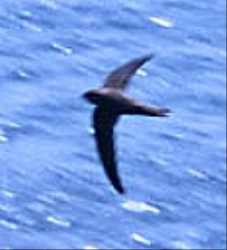
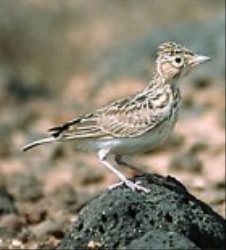 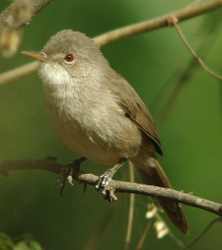 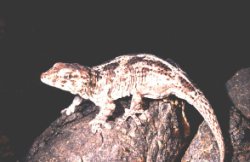
Cape Verde's isolation has resulted in the islands having a
large number of endemic species, many of
which are endangered by human development. Endemic
birds include Alexander's Swift (Apus alexandri), Raso Lark (Alauda razae), Cape Verde Warbler (Acrocephalus brevipennis),
and Iago Sparrow (Passer iagoensis),
and reptiles include the Cape Verde
Giant Gecko (Tarentola gigas).
Economy
Cape Verde has few natural resources and suffers from poor
rainfall and limited fresh water. Only 4 of the 10 main islands (Santiago, Santo
Antão, Fogo, and Brava) normally support significant agricultural production,
and over 90% of all food consumed in Cape Verde is imported. Mineral resources
include salt, pozzolana (a volcanic rock used in cement
production), and limestone. The economy of Cape Verde is
service-oriented, with commerce, transport, and public services accounting for
more than 70% of GDP. Although nearly 70% of the
population lives in rural areas, agriculture and fishing contribute only about
9% of GDP. Light manufacturing accounts for most of the
remainder. Fish and shellfish are plentiful, and small quantities are exported.
Cape Verde has cold storage and freezing facilities and fish processing plants
in Mindelo, Praia and on Sal. Expatriate Cape Verdeans contribute an amount
estimated at about 20% of GDP to the domestic economy through remittances.
Since 1991, the government has pursued market-oriented economic
policies, including an open welcome to foreign investors
and a far-reaching privitisation program. It established as
top development priorities the promotion of market economy and of the private sector; the development of tourism, light manufacturing industries, and fisheries; and the development
of transport, communications, and energy facilities. From 1994 to 2000 there was a total of about
$407 million in foreign investments made or planned, of which 58% were in
tourism, 17% in industry, 4% in infrastructure, and 21% in fisheries and
services.
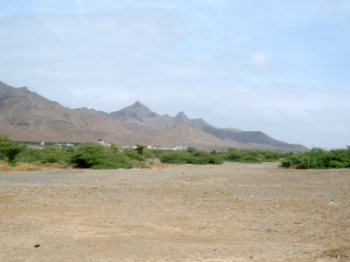 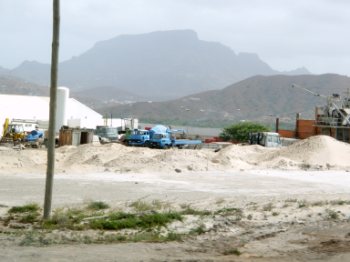 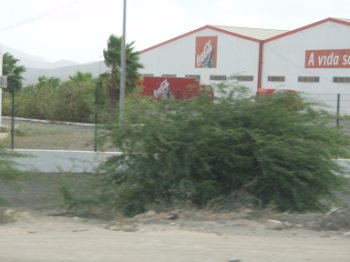
The airport on Sao
Vicente will become international soon, the cement
works and the Coca-Cola factory.
Cape Verde's strategic location at the crossroads of
mid-Atlantic air and sea lanes has been
enhanced by significant improvements at Mindelo's harbour
(Porto Grande) and at Sal's and Praia's international airports. A new
international airport was opened in Boa
Vista in December 2007. Ship repair
facilities at Mindelo were opened in 1983. The major ports are Mindelo and
Praia, but all other islands have smaller port facilities. In addition to the
international airport on Sal, airports have been
built on all of the inhabited islands. All but the airport on Brava enjoy
scheduled air service. The archipelago has 3,050 kilometers (1,830 mi.) of
roads, of which 1,010 kilometers (606 mi.) are paved, most using
cobblestone.
The country's future economic prospects depend heavily on the maintenance of
aid flows, the encouragement of tourism, remittances, outsourcing labor to
neighboring African countries, and the momentum of the government's development
program. Cape Verde has significant cooperation with Portugal at every level of
the economy, which has led it to link its currency first to the Portuguese
escudo and, in 1999, to the
euro. On June 23, 2008 Cape Verde
became the 153rd member of the WTO.
Demographics
Around 71 percent of the population is Creole of mixed black African and
Portuguese descent. The remainder of the population is
mostly black Africans, with a small number of whites.
The European men who colonized Cape Verde did not usually bring wives or
families with them. As female African slaves were
brought to the islands, inter-marriages
occurred.
More than 85 percent of the population is nominally Roman Catholic, though Catholicism is often
melded with traditional African religions. The largest Protestant denomination is the Church of the Nazarene;
other groups include the Seventh-day Adventist Church, the
Mormons, the Assemblies of God, the
Universal Church of the Kingdom of God and various
other Pentecostal and evangelical groups. There are small Baha'i communities
and a small but growing Muslim community. The number of
atheists is estimated at less than 1 percent of the
population.
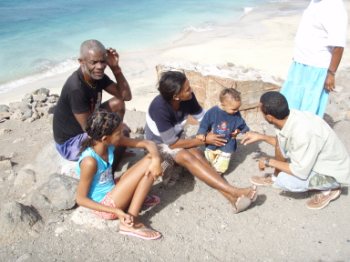 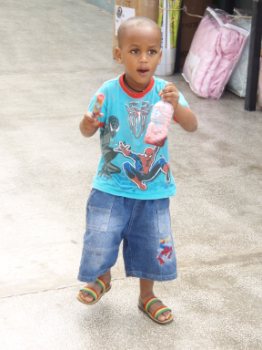 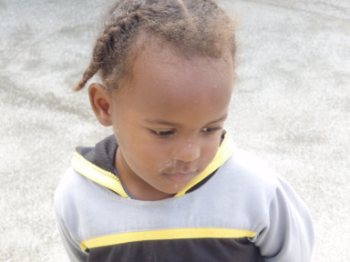
Cape Verde's official language is Portuguese. It is the
language of instruction and official acts. However, the Cape Verdean
Creole is used colloquially and is the mother tongue of
virtually all Cape Verdeans. Cape Verdean Creole or Kriolu is a dialect
continuum of a Portuguese-based creole, which varies
from island to island. There is a substantial body of literature in Creole,
especially in the Santiago Creole and the Sao Vicente
Creole. Creole has been gaining prestige since the
nation's independence from Portugal. However, the differences between the varied
forms of the language within the islands have been a major obstacle in the way
of standardization of the language. Some people have advocated the development
of two standards: a North (Barlavento) standard, centered on the São Vicente
Creole, and a South (Sotavento) standard, centered on the Santiago Creole.
Manuel Veiga, PhD, a linguist by training, and Minister of Culture of Cape
Verde, is the premier proponent of Kriolu's officialisation and
standardisation.
Cape Verdeans
Today, more Cape Verdeans live abroad than in Cape Verde
itself, with significant communities in the US (about
500,000, with a major concentration on the New England coast from Providence,
Rhode Island, to New Bedford, Mass.), Portugal (80,000)
and Angola (45,000). There is also a significant number
of Cape Verdeans in Sao Tome and Principe,
Senegal, France,
Brazil, Luxembourg and the
Netherlands. Cape Verdean populations also settled in
Spain, Germany, and other CPLP
countries such as Guinea-Bissau.
Culture
Cape Verdean social and cultural patterns are similar to those
of rural Portugal, but some African patterns remain. Soccer games and church
activities are typical sources of social interaction and
entertainment. The traditional walk around the praça
(town square) to meet friends is practiced regularly in Cape Verdean towns. In
towns with electricity, Cape Verdeans have access to television and watch Cape
Verde’s programs on two channels (Cape Verdean and Portuguese).Cape Verdean
music incorporates Portuguese, African, and Brazilian influences. Cape Verde's quintessential national music is the morna, a melancholy and lyrical song form typically sung in Cape Verdean
Creole. Other popular musical genres include funana
and batuque music. Amongst the
most world-wide known Cape Verdean singers, is the singer Cesaria
Evora, whose songs became a hallmark of the country and
its culture.
Cape Verdean literature is one of the richest of
Lusitanian Africa. Famous poets include Frusoni Sergio, Tavares Eugénio, and
B.Léza, and famous authors include Manuel Lopes,
Henrique Teixeira de Sousa, and Almeida
Germano.
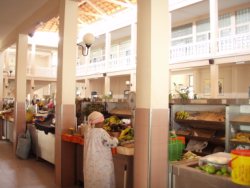  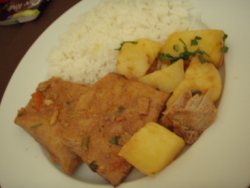 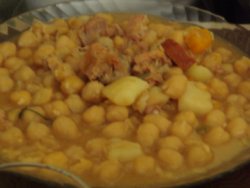
The municipal market, chicken paella,
tuna steak and chickpeas, all dishes we have tried. The Cape Verdean diet is mostly based on fish and staple foods like
corn and rice. Vegetables available during most of the year are potatoes,
onions, tomatoes, manioc, cabbage, kale, and dried beans. Fruits like banana and
papayas are available year-round, while others like mangoes and avocados are
seasonal, fruit and veg is not cheap to buy. The Government sets the prices, so
no hassle with bartering.
Health, education, and development
Primary school education in Cape Verde is mandatory between the
ages of 6 and 14 years and free for children ages 6 to 12. Textbooks have
been made available to 90 percent of school children, and 83 percent of the
teachers have attended in-service teacher training. Although most children have
access to education, some problems remain as many students and some
teachers speak Creole at home and have a poor command of Portuguese (the
language of instruction); there is insufficient spending on school materials,
lunches and books; and there is a high repetition rate for certain grades. The
strange thing for us - you just don't see many old people - there are a few of
course, but twenty years ago the life expectancy was only 46. It has increased
significantly with better health care for those who can afford it. The average
wage for a factory worker is between 6 and 8 thousand ESC a month - £53.10
to £70.80. There is no minimum wage and employers can pay what they want, or not
as the case may be. That is why you see so much begging/ offers to do casual
labour and unfinished housing. Some prefer shopping to money, many have
asked us to buy baby formula or nappies, we have seen tourists offer money and
been taken to the supermarket. Quite sad really.
Cape Verde has been steadily developing since its independence, and besides
having been promoted to the group of "medium development" countries in 2007,
leaving the Least Developed Countries category (which is
only the second time it has happened to a country), is currently the 5th best
ranked country in Africa in terms of Human Development
Index.
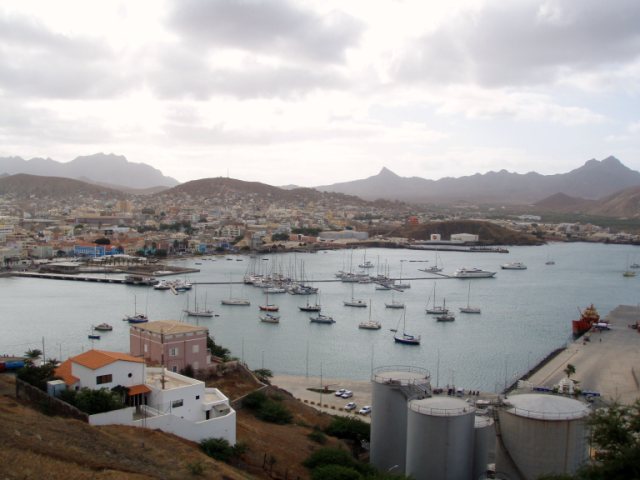
All in all an interesting,
young place to visit - but- don't forget it is technically
3rd World, so no comparing to holidaying in the
Mediterranean.
|























